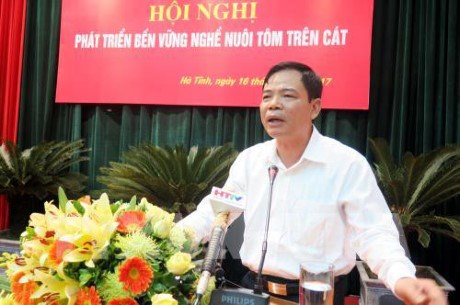Central coastal provinces eye sustainable shrimp farming
A conference was held in the central province of Ha Tinh on May 16 to seek ways to sustainably develop sand-based shrimp farming, for which the central coastal region holds huge potential.
 Minister of Agriculture and Rural Development Nguyen Xuan Cuong speaks at the conference. (Source: VNA)
Minister of Agriculture and Rural Development Nguyen Xuan Cuong speaks at the conference. (Source: VNA)Ha Tinh (VNA) – A conference was held in
the central province of Ha Tinh on May 16 to seek ways to sustainably develop
sand-based shrimp farming, for which the central coastal region holds huge
potential.
Minister of Agriculture and Rural Development Nguyen Xuan Cuong elaborated that these provinces own favourable conditions such as clean saltwater sources. Meanwhile, they are also tourism destinations which are a good market for shrimp consumption.
The region ranks second, behind the Mekong Delta, in terms of shrimp farming. Notably, the north central provinces own great potential for rearing white-leg shrimps, he noted.
The region has a large area of sand, between 12,000 – 14,600ha, on which shrimp farming will make use of infertile soil here.
The Government has issued development directions for the shrimp sector, targeting export revenue of 8-10 billion USD by 2025.
However, the central coastal provinces are also vulnerable to natural disasters like storms and flood which have affected local infrastructure, Cuong added.
There are currently nearly 696,000ha of brackish water shrimp farming in Vietnam, with a total output of more than 657,000 tonnes. Shrimp products have been exported to 90 foreign markets, bringing home more than 3 billion USD each year.
Fourteen central coastal provinces are farming shrimps in a total areas of more than 3,730ha, a strong increase from about 2,380ha in 2010, producing nearly 42,000 tonnes of shrimps. High productivity is recorded in Quang Nam, Quang Ngai, Binh Thuan and Ninh Thuan.
However, sand-based shrimp farming in the central coastal region is carried out spontaneously. Local irrigation systems haven’t been built specifically for aquaculture, leading to the prevalence of shrimp diseases, according to the Directorate of Water Resources.
Minister Cuong asked the provinces to survey land that can be used for farming shrimps while ensuring environmental protection and the farming of other animals or crops.
Meanwhile, businesses should connect with each another and with farmers to develop shrimp breeding and farming technology, share experience and boost sales. Relevant ministries and sectors need to have planning for shrimp farming areas and work out development solutions for this industry, he added.-VNA
Minister of Agriculture and Rural Development Nguyen Xuan Cuong elaborated that these provinces own favourable conditions such as clean saltwater sources. Meanwhile, they are also tourism destinations which are a good market for shrimp consumption.
The region ranks second, behind the Mekong Delta, in terms of shrimp farming. Notably, the north central provinces own great potential for rearing white-leg shrimps, he noted.
The region has a large area of sand, between 12,000 – 14,600ha, on which shrimp farming will make use of infertile soil here.
The Government has issued development directions for the shrimp sector, targeting export revenue of 8-10 billion USD by 2025.
However, the central coastal provinces are also vulnerable to natural disasters like storms and flood which have affected local infrastructure, Cuong added.
There are currently nearly 696,000ha of brackish water shrimp farming in Vietnam, with a total output of more than 657,000 tonnes. Shrimp products have been exported to 90 foreign markets, bringing home more than 3 billion USD each year.
Fourteen central coastal provinces are farming shrimps in a total areas of more than 3,730ha, a strong increase from about 2,380ha in 2010, producing nearly 42,000 tonnes of shrimps. High productivity is recorded in Quang Nam, Quang Ngai, Binh Thuan and Ninh Thuan.
However, sand-based shrimp farming in the central coastal region is carried out spontaneously. Local irrigation systems haven’t been built specifically for aquaculture, leading to the prevalence of shrimp diseases, according to the Directorate of Water Resources.
Minister Cuong asked the provinces to survey land that can be used for farming shrimps while ensuring environmental protection and the farming of other animals or crops.
Meanwhile, businesses should connect with each another and with farmers to develop shrimp breeding and farming technology, share experience and boost sales. Relevant ministries and sectors need to have planning for shrimp farming areas and work out development solutions for this industry, he added.-VNA













